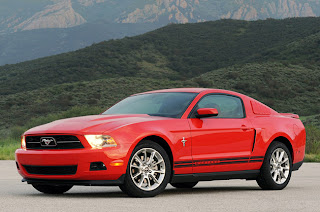
2011 Ford Mustang V6
To many, the terms "Mustang" and "high technology" are as mutually exclusive as "China" and "transparent, open society." After all, the first Mustang rolled off the assembly line before the Vietnam War got under way, and in the minds of most people it hasn't changed all that much in the 4.5 decades since. Sure, every once in a while Ford will bolt a fairly high-tech motor into a special edition 'Stang (SVT, Cobra, GT500), but for the most part the original pony car represents exactly that: the origin of the species. Especially when it comes to the base model, the until now lowly – some might say primitive – V6 iteration.
For seemingly ever, Ford has been content to let its low-hanging fruit edition Mustang rot away in irrelevance. Nothing seemed to make the Blue Oval boys happier than stocking every rental car fleet in the nation with soft-riding, underpowered has-beens. Let's make that never-rans. So for the performance minded buyer, the V6 version of the Mustang never even entered the picture. Worse, do you know what car people interested in a V6 Mustang cross-shopped the most? Pat yourself on the back if you said Honda Accord Coupe. In other words, the V6 Mustang was never a sports car.
Now, along comes the 2011 model year and you can throw everything you thought you knew about Ford's entry-level pony car out the window. It simply no longer applies. Gone is the archaic, universally unloved and soon to be totally forgotten 4.0-liter V6. In its place is a very high-tech version of Ford and Mazda's 3.7-liter 60-degree V6. With it, the 2011 Ford Mustang V6 produces 305 horsepower, 280 pound-feet of torque, and yet returns 31 mpg on the freeway according to the EPA. In fact, as Ford was happy to tell us (quite a a few times), the 2011 V6 is the only car ever to produce 305 hp and get 31 mpg. Fabulous numbers no doubt, but they only tell part of the story. In our opinion, the Mustang V6 could be the most significant car released this year.
Before we get to the significant part, we'll start with the car itself. For 2011, all Mustangs receive new front and rear fascias. Part of the reason is, of course, aesthetic, but the bulk of the impetus behind the change has to do with mileage. In other words, Ford is getting serious about aerodynamics. As such, the 2011 Mustangs are four percent slipperier than last year's models, which themselves were brand new designs. The V6 aero-tweaks include a new upper grill, lower front-spoiler and air dam, an underbody "aeroshield," a decklid seal and rear wheel spats.


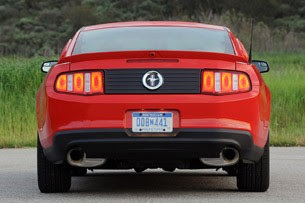
A few years ago, Jeremy Clarkson produced a DVD called The Good, the Bad and the Ugly. In it, he came to California and basically explained that all American cars are shite, save his precious Ford GT. There's a particularly noteworthy segment where he races a Mustang against a horse around a quarter-mile track. He claims it's the (at the time) 300-hp GT model. Predictably, the Mustang loses the race. Hey, it's Clarkson – he's made millions bashing the US of A. However, those in the know noticed about halfway through the clip that Jezza's not driving a GT, he's actually behind the wheel of a V6. The big giveaway? A single tailpipe. Well guess what? All V6 Mustangs now ship with dual pipes. Inside, it's more of the same good stuff we met with the 2010 refresh, but as Mustang chief engineer Dave Pericak points out, everything that looks like metal is actually metal. Hooray! And, of course, Sync is still at the top of the infotainment pile.
About that engine: It's a peach. Similar in bore (if not a few internals) to the all-aluminum 3.7-liter you'd find in the 280-hp Mazda CX-9, the 2011 Mustang's V6 comes equipped with some fancy heads that feature fully variable intake and exhaust valves. Ford calls the technology Twin Independent Variable Camshaft Timing or Ti-VCT for the short and unmemorable. Like all variable valve-timing setups, a computer is able to adjust the flow into and out of the engine. Ford claims it takes just "microseconds" to recalibrate the cams and ensure that the engine is always breathing optimally. Again, the results are 305 hp and 280 lb-ft of torque, up from the previous engine's paltry 210 hp and a just-okay-but-not-great 240 lb-ft of spin. Also, the redline's up to 7,000 rpm.


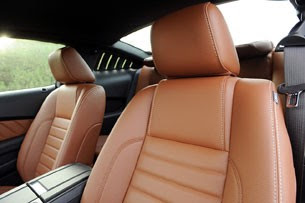

Other bits of new mechanical tech include two all-new six speed transmissions – your choice of automatic or manual (we highly recommend the manual, though the auto is fine, kinda) – and a revised suspension, a limited slip differential (see the burnout pics in the gallery), a cold air intake, a weight-saving plastic fuel tank and a host of NVH improvements that make the vehicle 15-percent stiffer than last year's car. Most importantly, the brakes have been enhanced, mostly by way of a larger brake booster. The question then becomes what's all this new stuff add up to?
One shockingly fun-to-drive entry level Mustang, that's what.
While obviously not quite as straight-line potent as a 2010 GT, the 305-hp V6 and its $22,995 starting price (that's including destination) is a pretty startling performance proposition. We're guessing here, but 0-60 mph and quarter-mile times are probably better than cars like the Mazdaspeed3, Volkswagen GTI and Chevrolet Camaro V6. Figure around 5.5 seconds to 60 miles per hour (or even slightly less) and the quarter-mile in about 14 seconds flat at around 105 mph. We won't be surprised if instrumented tests reveal the new V6 is even quicker, as the engine really is more than an admirable performer and the solid rear axle, in conjunction with the new limited slip, puts the power down in spectacular, tire-smoking fashion.




But of course, that solid rear axle means that the Mustang V6 can't go around corners, right? After all, that was Jeremy Clarkson's entire point in his video (and about 20-percent of the sentences he's ever written). Well, in this situation, Jeremy is quite wrong. When the 2010 Mustangs were released, Ford based them on the 2009 Bullitt Mustang, a car that never had to make any apologies for its handling. Starting with that solid foundation (no pun, no pun), Ford has further improved the Mustang's rear end for 2011 to the point where they were so confident with their work, they set up an autocross track for us to compare the new Mustang V6 against the 304-hp, 273 lb-ft of torque 2010 Camaro V6 RS, its most direct competitor.
Not to overstate things, but the four-wheel independently sprung Camaro felt prehistoric compared to the lighter and more sprightly Mustang. Actually, the Camaro's ponderousness helped it out on Ford's track, as it was a second gear affair (meaning nothing but quick turns and big braking zones), but even on the broken asphalt the cars were running over, we much preferred the Mustang's moves and prowess to the frankly clunky, chunky Camaro. Also, your author is about 5'11" standing up straight, 5'10" otherwise. By no means tall. Yet while wearing a helmet in the Camaro, yours truly was tall enough to get caught against the Chevy's roof, which prevented proper visibility while turning. No such problems in the more spacious Ford, and further proof that the 2011 Mustang V6 is the more serious sports car, if not just a plain better car.

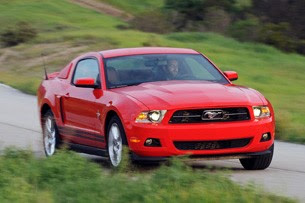
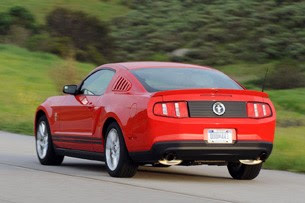
On the highway, the Mustang V6 proved even more impressive. With that lofty new redline in place and relatively tall gearing, you can really beat on the engine without worrying about hitting fuel cutoff. Another way to look at this is that you have to pound on the 3.7-liter to get it to come to life. But hey, beating on a car like this is half the fun. Unless you're in the shorter first or second gears, you can forget all about hitting the 7,000 rpm redline. It's just not going to happen. That said, burnouts are seriously, ludicrously easy to pull off. Before you go calling us childish, remember that smokey, tire-abusing burnouts are most likely a Mustang design prerogative.
Through the twisty stuff, the 2011 V6 impressed us with handling that was leaps and bounds better than expected. The lighter, smaller, aluminum mill better balances the car's weight and makes for a nimbler steer. That's correct, the V6 Mustang changes direction quite confidently. The chassis tackles turns quite well, and there's none of the twisting, clunking or falling down we've long associated with the bottom rung Mustang. If we have one complaint it's that the front springs are a little floppy. Meaning that at higher speeds the front-end floats and bobs around too much. Nothing catastrophic, but we would have liked a more tied down nose. For that, there's always the aftermarket. Of course, looser springs mean a more comfortable ride, and the V6 is certainly pleasant to drive.

Right, so Ford's transformed an uninteresting rental appliance into a legitimate performance car and kept the price down. A neat trick, but how on earth does this equate to "the most significant car released this year?" Here's how. Like they always do, automakers screamed bloody murder en masse and assured us that if a 35 mpg CAFE standard (i.e. fleet average) for 2020 became the law of the land, they would all immediately go bankrupt. Well, two of them did, but that's not related. Anyhow, here's Ford with a 305-hp vehicle that gets 31 mpg in March of 2010. Just imagine what the 2021 Mustang's numbers will be like! The point is that Ford's going to be able to easily meet a 35 mpg fleet average without sacrificing fun. That rocks, and is an undeniable challenge to the rest of the industry.
To further drive home the point, Ford's not even throwing its best kung fu at the 2011 Mustang V6. Its EcoBoost technology has been left on Dearborn's cutting room floor – for now. Even without turbocharging, we again implore you to imagine what this motor will be like when outfitted with mileage-enhancing direct injection (it's coming) or other fuel sipping tricks like cylinder deactivation and/or auto stop/start. 350 horsepower and 35 miles per gallon is not as ludicrous as it sounds. With Ford's newly found aggressive product cycle, we might even see stats like that in 2012. As it stands today, the 2011 Ford Mustang V6 is the entry level pony car to beat.
Source: Autoblog

No comments:
Post a Comment